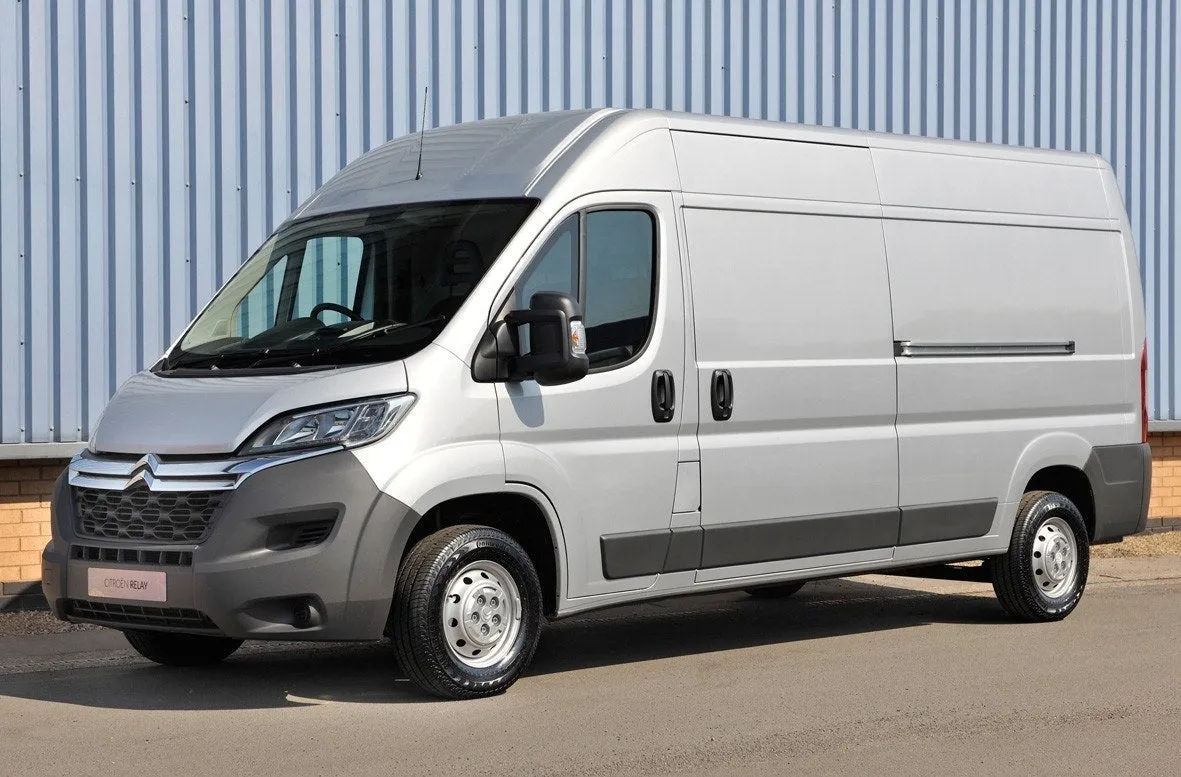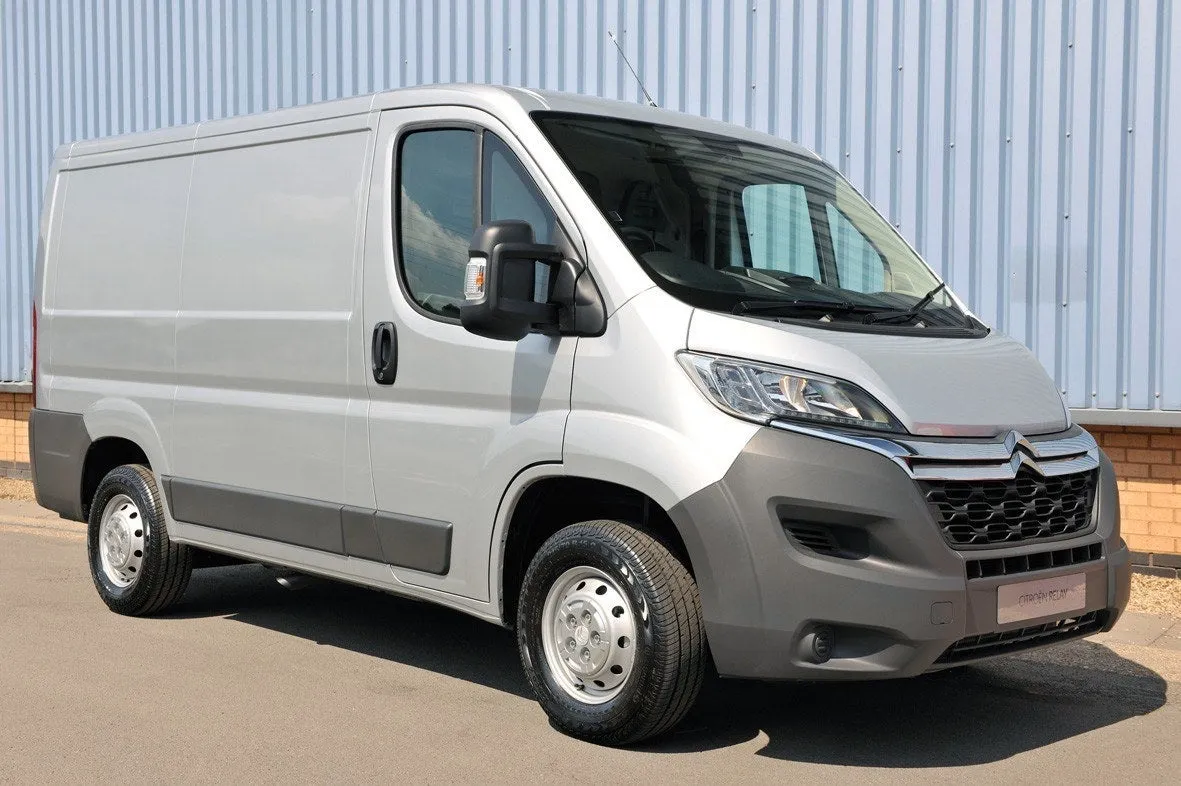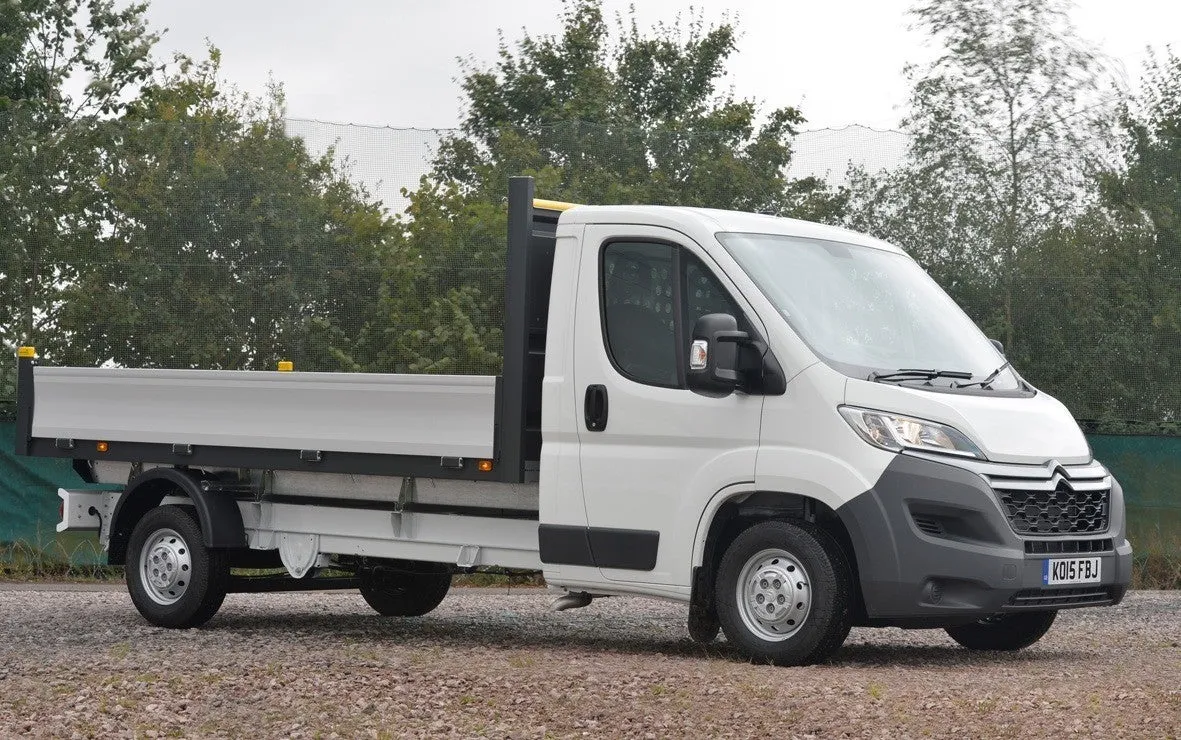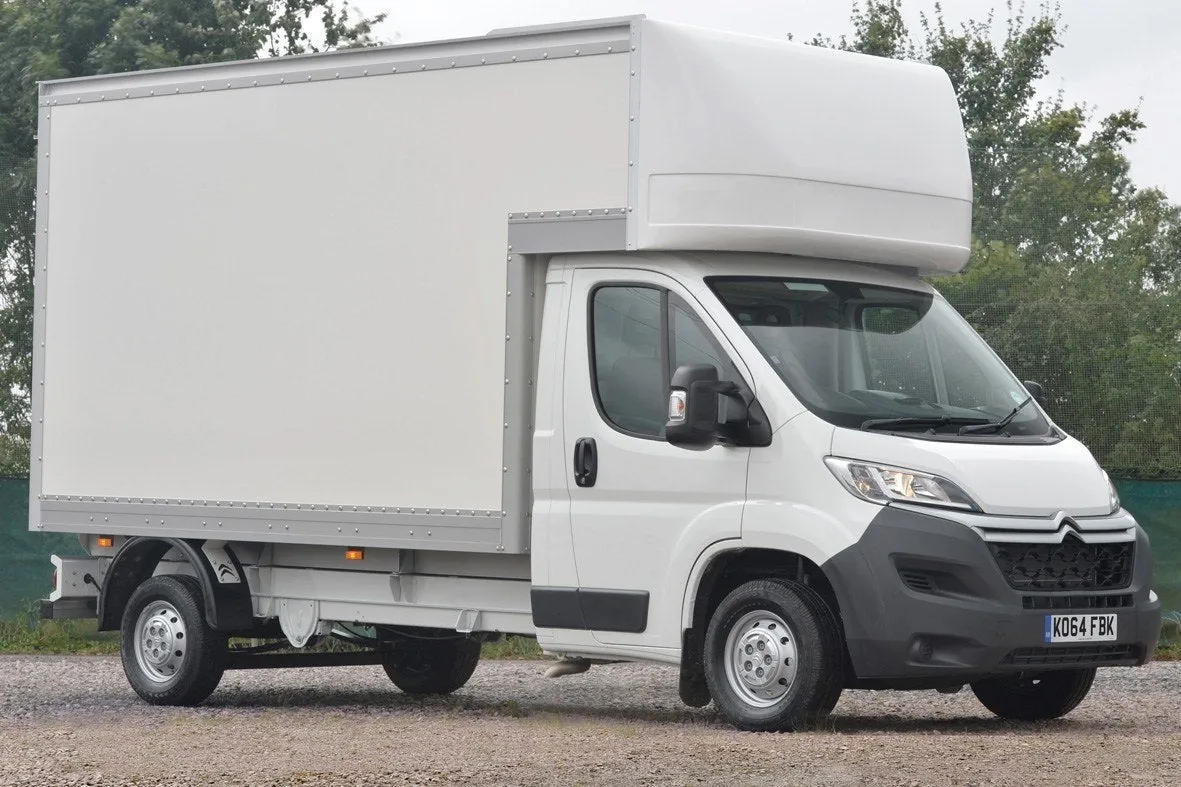Citroen Relay Review 2024
Written by Andrew Brady
Quick overview
Pros
- One of the largest vans in its class
- Wide choice of wheelbases and heights
- Punchy engines
Cons
- Drab plastics
- Passenger bench seat is not as comfortable as it should be
- Noisy at speed
Overall verdict
"Jointly developed with Fiat and Peugeot, the Relay is a good large van that majors on carrying big loads for the lowest possible cost. "

This explains why it is one of the few serious threats to the Ford Transit’s superiority in this corner of the market.
The workmanlike appearance of the Citroen Relay’s cab tells you all you need to know about this van. It’s here to work and do a job, and do it well. This sums up the Relay’s approach to life and the cab offers a high-set driving position to give a great view of the road ahead. There’s also good vision from the side windows, though reversing can be tricky due to the Relay’s size. Load volumes span from eight to 17 cubic metres, while all get a useful 1.4 metres between the wheel arches. Payloads range from 1155kg to 1900kg.
All Relay models get navigation as standard in all models. This helps separate the Relay from its large van rivals and is a good selling point; however you have to spec up to Enterprise trim to get air conditioning and parking sensors.
The Relay comes with a choice of four body lengths, three roof heights and a spread of 110PS, 130PS and 150PS 2.2-litre turbodiesel engines and a 3.0-litre turbodiesel with 180PS. In 2016 Citroen introduced a range of Euro6 2.0 BlueHDi engines, with lower running costs and emissions. Power outputs, however, remain virtually unchanged.
The Relay has some of the lowest running costs in its class, with advertised fuel economy peaking at 48.7mpg for panel van versions and 42.8mpg for dropsides. What might put you off the Relay is the amount of wind and road noise that can be heard in the cabin.
In 2022, Citroen added a fully electric version of the Relay to the range. Dubbed the e-Relay, it's available as a panel van in three sizes, with a window van and chassis cab option also available. It's not an in-house conversion, instead the e-Relay is converted from a diesel model by a third-party company in Turkey. Although it's expensive to buy, that'll be offset by the massively reduce fuel costs for fleet buyers.
While the engines are decently quiet and keep to themselves at higher speeds, the amount of whistle and grumble from wind and road noise can leave you wishing for a set of earplugs. The ride is also quite bumpy when the van is lightly loaded. This is a real shame for the Relay, especially when the Ford Transit is noted for its quiet and comfortable nature.
Similar vans to consider include the Vauxhall Movano, Volkswagen Crafter and the Peugeot Boxer. Looking for a used van for sale? We've got 100s of Citroen Approved Used Cars for Sale for you to choose from, including a wide range of Citroen Relay vans for sale.
Comfort and design
"Comfort in the cab is supplemented with electric windows, central locking and a dash-mounted clipboard."

There is also a large glovebox in front of the passenger seat and another in the centre of the dash that can be locked for added security. Other storage is taken care of by a lidded cubby in the dash and cupholders.
For that complete mobile office experience, the Relay also comes with a passenger bench seat that folds to create a desk. This is perfect for dealing with paperwork or for keeping a laptop computer safely in place when not using it while driving.
The driver’s seat is normally sprung as standard, but there is the option of adding suspension for those who spend long hours behind the wheel without many breaks. For the passengers, comfort is not quite as high a priority it would seem for Citroen’s seat designers as the bench is thinly padded, though there is plenty of space for knees, elbows and shoulders.
A large glass area in the Relay’s cab means the air conditioning that is standard with the Enterprise model is all but essential unless you live in the chilliest parts of the country. During the warmer months, air con makes the Relay’s cab a much more pleasant place to be and helps reduce driver fatigue.
The electric Citroen e-Relay has a bit of an odd interior, and it's clear the EV conversion was done on a budget. Rather than bespoke dials, it has the same dials as the normal Relay with most of the needles removed, while the range and voltage is displayed in an aftermarket screen in the rear-view mirror. The temperature knob in the ventilation system isn't connected, either, as the temperature is adjusted with a cheap-looking screen to the right of the wheel. Still, it does the job.
Behind the cab lies a large cargo area that ranges in size from 8.0 to 17.0 cubic metres, putting the Relay right among the largest vans on sale in the UK. With generous maximum payload and towing capacities too, the Citroen can cope with most users’ needs. There is a heavy duty rear suspension option for the longest wheelbase models that can deal with 3.5-tonne and 4.0-tonne weights. The e-Relay's maximum payload is reduced to 1,150kg.
Load heights range from 1.6 metres for the smallest versions of the Relay (L1/H1) to 2.1 metres for the largest L4/H3 vans. Likewise, the load floor starts at 2.6 metres in length and extend to considerable 4.0 metres for the long wheelbase panel vans. Happily, the e-Relay's electric conversion doesn't impact on cargo space at all.
A low load sill (507mm - 561mm) makes it easy to lift heavy items in and out or for a forklift to slot home cleanly. If you go for the optional self-levelling suspension, the Relay’s load sill height can be further reduced to a tarmac-skimming 460mm. The twin side-hinged rear doors open wide to 180-degrees as standard and can be ordered at extra cost to open to 260-degrees. A sliding side door is standard on all models and buyers can order a second sliding side door as an option.
Engines, gearboxes and handling
"The Citroen Relay is notable in this sector for being one of the best vans to drive, putting it into contention with the Ford Transit of the same age."

An excellent range of turbodiesel engines helps here no end, with most based on the 2.2-litre unit. They come in 110PS, 130PS and 150PS guises and all come with a six-speed manual gearbox as standard.
The entry-point 110PS 2.2 HDi is a good bet for those who spend most of their time in and around town. It offers good low-rev shove and is smooth and quiet in use, though it does miss the extra poke of its more brawny sister units when it comes to dealing with motorways and passing slower traffic.
If you mix up your driving between town and the open road much more, the 130PS and 150PS 2.2-litre engines are the way to go. They power the Relay with assured strength and make light work of most conditions, with the more potent of the two the better choice for those who make full use of the Relay’s considerable payload and towing capacity.
Finally, there’s the 3.0-litre four-cylinder turbodiesel with 180PS that will be the choice of those who need long haul comfort, refinement and power. There is a trade-off between economy, emissions and performance with this motor, but if you need the extra wallop this engine offers, the cost equation will not put you off.
In 2016 Citroen downsized the engine choices, with the introduction of a 2.0 BlueHDi engine, with Euro6 emission standards and better economy. Power outputs range from 110PS, 130PS and 163PS, with the latter providing 350Nm of torque.
In 2022 Citroen added the fully electric e-Relay. This uses a 120PS electric motor powering the front wheels, with a 37kW or 70kW battery. It's a lot smoother and quieter than the diesel versions, but performance is more leisurely at low speed, picking up above 30mph. The top speed is 75mph, which is more than enough - but doing that speed for any length of time will decimate the range.
The Relay is also a handy van to have on your side when it comes to taking corners. It has light, accurate steering that helps the driver place the van on the road, so no danger of wandering over white lines or straying too close to the verge in this van.
The steering is also good when it comes to parking and positioning the Relay thanks to its tight turning circle and easy to whirl steering wheel. There are standard rear parking sensors on the Enterprise model, which makes reversing the Relay a much easier task.
MPG and fuel costs
"The 2.2-litre diesel engine was improved in 2014 for increased efficiency, while the electric e-Relay will save a great deal on fuel costs"

The HDi unit comes in versions of 110PS, 130PS and 150PS, all with a six-speed, all-synchromesh manual gearbox. The 130PS engine is also available as an e-HDi with engine start/stop which sees official economy of 42.8mpg (for the Relay 30). All Relay panel vans of up to 3.5 tonnes have sub-200g/km CO2 emissions which reduces to 175g/km for the Relay 30 e-HDi.
The Citroen e-Relay is only available as a 120PS version. With a range of 73 miles with the smaller battery and 139 miles with the larger battery, we reckon the larger battery is the only one that will be of use to most buyers.
The e-Relay obviously saves a lot on fuel costs, but then it's substantially more to buy or lease than the diesel version. It can be rapid charged at up to 50KW, meaning an 80% charge is possible in around an hour.
What equipment is the Citroen Relay fitted with?
"Go for a later model for the best levels of kit."

From 2014, the cab gets a new trim of dark grey and black and red twill seat cloth plus a redesigned dashboard while electric windows, electric and heated door mirrors, DAB radio and Bluetooth are all standard fit. Another facelift in 2019 saw the introduction of Relay X featuring ABS, ESP, driver airbag, Hill-start Assist, 12V socket and a full steel bulkhead.
The popular Enterprise model specification includes rear park assist, MP3 audio system with a 5-inch colour screen including satellite navigation, driver’s seat with arm rest, height adjustment and lumbar adjustment. These features make the Citroen Relay an essential partner for business customers with varied business activities and needs, in a particularly demanding LCV market.
Relay WORKER targets professionals transporting equipment and people to all types of work sites, often those difficult to access. Featuring underbody protection, front mud flaps (all body variants) and rear mud flaps (vans), it also boasts improved grip through the fitment of Grip Control with Hill Descent Control and multi-season tyres. Cabin equipment includes an audio system with a Bluetooth hands-free kit and USB socket, a cruise control/speed limiter function, and a dashboard-mounted clipboard.
Relay DRIVER is designed for LCV customers who make longer journeys or numerous deliveries both in and out of the city. It stands out with its driving comfort, supported by the following equipment: a USB charging socket, reversing camera, navigation system and Drive Assist Pack (including Active Safety Brake, Lane Departure Warning System, automatic headlamps with smart beam function, automatic front wiper and speed sign recognition).
Relay also became available with a blind spot monitoring system that can take account of trailers, and rear traffic alert, which detects vehicles up to 50 metres away coming from the left or right when drivers shift into reverse. Relay is also now fitted as standard with a telematics box for Free2Move Connect Fleet Services, including fuel consumption monitoring, vehicle tracking in the event of theft, vehicle tracking for fleets, maintenance monitoring and eco-driving.
Get our latest advice, news and offers
Keep me updated by email with the latest advice, news and offers from heycar.
By submitting you agree to our privacy policy



